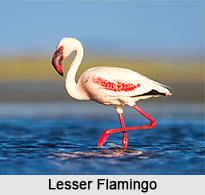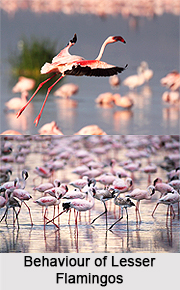 Lesser Flamingo along with the scientific name "Phoeniconaias minor" is a species of flamingo occurring in sub-Saharan Africa with another population in India.
Lesser Flamingo along with the scientific name "Phoeniconaias minor" is a species of flamingo occurring in sub-Saharan Africa with another population in India.
Migration of Lesser Flamingo
Lesser flamingos are occasionally reported from further north, but these are generally considered vagrants. Until 2014, it was classified in genus Phoenicopterus but is now classified the only species in the genus Phoeniconaias.
Lesser Flamingo as the Smallest Species
Lesser flamingo is the smallest species of flamingo, though it is a tall and large bird by most standards. The species can weight from 1.2 to 2.7 kg. The standing height is around 80 to 90 centimetres.
Structure of Lesser Flamingo
The total length of Lesser flamingo is from beak to tail. The wingspans are in the same range of measurements, from 90 to 105 cm. Most of the plumage is pinkish white. The clearest difference between this species and the greater flamingo, the only other Old World species of flamingo, is the much more extensive black on the bill. Size is less helpful unless the species are together, since the sexes of each species also differ in height.
Population of Lesser Flamingo
Lesser Flamingo may be the most numerous species of flamingo, with a population that probably numbers up to two million individual birds. This species feeds primarily on Spirulina, algae which grow only in very alkaline lakes.  Presence of flamingo herds near water bodies is indication of sodic alkaline water which is not suitable for irrigation use. Although blue-green in colour, the algae contain the photosynthetic pigments that give the birds their pink colour. Their deep bill is specialised for filtering tiny food items. The lesser flamingo also feeds on shrimp.
Presence of flamingo herds near water bodies is indication of sodic alkaline water which is not suitable for irrigation use. Although blue-green in colour, the algae contain the photosynthetic pigments that give the birds their pink colour. Their deep bill is specialised for filtering tiny food items. The lesser flamingo also feeds on shrimp.
Concentration of Lesser Flamingo
Lesser flamingo also breeds in south western and southern Asia. In 1974, they bred at the Rann of Kutch, but since then only at the Zinzuwadia and Purabcheria salt pans in north-western India.
Breeding of Lesser Flamingo
Lesser flamingo they lay a single chalky white egg on a mound they build of mud. Chicks join creches soon after hatching, sometimes numbering over a hundred thousand individuals. The creches are marshalled by a few adult birds who lead them by foot to fresh water, a journey that can reach over 20 miles. The population in the two key east African lakes, Nakuru and Bogoria, have been adversely affected in recent years by suspected heavy metal poisoning, while its primary African breeding area in Lake Natron is currently under threat by a proposed soda ash plant by Tata Chemicals. The only breeding site in South Africa, situated at Kamfers Dam, is threatened by pollution and encroaching development. The lesser flamingo is one of the species to which the Agreement on the Conservation of African-Eurasian Migratory Waterbirds (AEWA) applies.



















